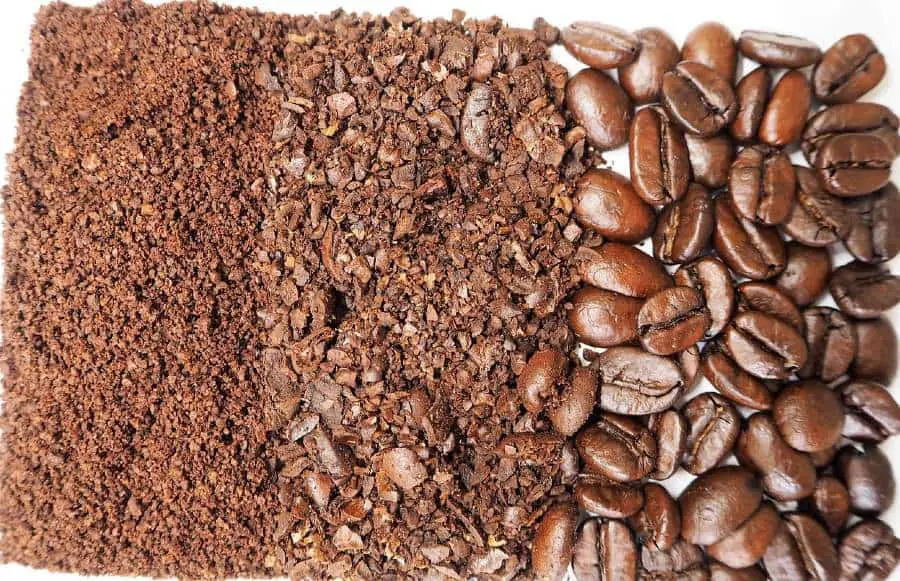
How to Grind already Ground Coffee
Have you ever bought some coffee beans and had them ground for you only to realize that the grind size is too coarse for your coffee brewing method? A coarse grind can also happen at home when you forget to adjust a grinder that was preset to a coarse setting. What should you do with your bag of coarsely ground coffee?
Can you grind already ground coffee?
Yes, you can grind already coffee to achieve the desired grind size. When regrinding coarse ground coffee you may want to take into account the type of grinder you are using to avoid over-grinding that can produce undesirable super-fine grounds. Regrinding, when done correctly, should not degrade the quality of the coffee.
Ideally, there is a brewing method for every size of ground coffee, and having some coarse coffee grounds should not necessarily prompt regrinding. However, we all have a preferred coffee brewing method and some people would rather stick to that method.
With the right tips, regrinding ground coffee should neither be troublesome nor reduce the quality of your coffee. You can use a burr grinder or a basic blender jar to achieve a finer grind.
In any case, regrinding coffee grounds is an essential step to achieve a consistent grind size when grinding coffee beans with blade grinders including food processors.
A burr grinder is easy to use when grinding pre-ground coffee as all you need is a few clicks to set the burrs to the preferred grind size, throw in the pre-ground coffee small amounts at a time to avoid jamming the grinder. Grind and voila, your grounds are ready.
A blade grinder on the other hand, requires some few tricks for consistency and to avoid a super-fine grind size.
7 Tips When Grinding Already Ground Coffee
These tips apply to a regular blade grinder for coffee as well as other equipment with blades that you can use to grind coffee such as food processors and blenders.
Materials: grinding equipment, a small receptacle, pre-ground coffee
Optional: paper towels and a mesh strainer
- Regrind only the amount of coffee that you need to brew as coarser grounds can maintain freshness better than finer grounds
- Determine the grind size that you want to achieve. This is a seemingly obvious but very important step. Different brewing methods use different grind sizes. Use a sample of the grind size that you desire, probably from a previous batch of ground coffee. You can also use sugar or table salt to compare for a fine grind size
- Add fewer amounts of ground coffee at a time. This enables you to monitor the grind size more effectively
- Grind in short bursts to avoid over-grinding. Use the PULSE feature of the grinder or on-off technique for short bursts to grind pre-ground coffee
- Use a sieve to sift the fine grinds into a small receptacle and toss the coarse grinds back in the grinder until all the grounds go through the strainer
- Remove the super-fines. Spread all the reground coffee on a paper towel for a few seconds and hold the towel by the edges to put back the grounds into the receptacle. The super-fines stick to the towel and what you have in the container is a consistent grind size with no coarse grinds or super-fines
- Avoid overexposing the ground coffee to maintain its freshness. You are better off assembling all the materials that you need before starting to double grind the coffee to minimize the duration that you take. Coffee grounds stale pretty fast due to their larger surface area that hastens reactions with moisture, direct light, and heat. It shouldn’t take you more than 5 minutes, on the higher side, to grind already ground coffee for a few cups of coffee
If you are not after a uniform grind size, simply toss small amounts of ground coffee in the blade grinder and start grinding while shaking the grinder. Grind in short bursts for 3-5 seconds while eyeballing the size of the grind. The grounds should be ready for brewing.
Should You Grind Already Ground Coffee?
There are various cases where grinding already ground coffee is absolutely necessary:
- when you need a finer grind size and you have coarse grounds, for example, medium-coarse for the Chemex method and, fine grounds for the espresso machine and Moka pots
- when you are a stickler for a uniform grind and you are grinding coffee beans with a blade grinder
Otherwise, you do not have to regrind pre-ground coffee. Instead, you can steep the coarse grounds for four minutes in a French press for a hot cup of coffee or for 18-24 hours in cold water to make great cold brew coffee.
A French press suits the coarse grind size as water has adequate time to interact with the grounds and dissolve the solubles.
What Should You Do With Super Fine Ground Coffee?
Sometimes the opposite can happen where you grind or buy pre-ground coffee that is too fine. Super-fine ground coffee clogs coffee filters and blocks coffee from flowing through.
In Moka pots, very fine coffee grounds seep through to the top chamber leading to muddy coffee. Some people freak out and just dump the batch of super-fine grounds which is a bad choice because there are ways to brew with super-fine ground coffee:
1. The Turkish Coffee Way
- Add 1-2 teaspoons per 50ml cold water to a small saucepan. Add 1 teaspoon sugar (optional) and stir to mix
- Place the saucepan on the stove and turn the stove to medium heat
- Bring the coffee to a gentle boil. Bubbles will start forming and the coffee generates a froth
- Turn the stove off and either:
- Pour the coffee into a cup and wait for 1-2 minutes for the coffee grounds to settle at the bottom of the cup, or
- Rest the coffee in the saucepan for 1-2 minutes for the sediments to settle and then gently tilt the saucepan and pour the coffee into a cup leaving the sediments in the saucepan
- French press with a longer brew time.
- Not the most glamorous way to make coffee but it will do a good job instead of discarding your super-fine coffee grounds. Steep the coffee grounds in a French press but reduce the steeping time to about 8-12 hours to avoid overly strong coffee. Slowly pour the coffee over a cone-shaped paper filter to remove the fine sediments. Rinse the paper filter in freshwater before filtering to remove the taste of the paper. You can dilute the coffee by adding water or milk if it’s too strong.
Turkish coffee is strong and frothy with a rich flavor and aroma. It can be too strong when you are used to pour-over or drip coffee, so sweetening is an excellent choice when you are not used to drinking Turkish coffee.
2. How to Brew Super Fine Grounds in a French Press (Longer Brew Time and a Double Filter)
- Add the fine grounds in a French press at a ratio of 60 grams per liter of water
- Add near-boiling water in accordance with the coffee ratio
- Leave the French press to rest for five minutes without covering with the lid. The coffee will extract and the grounds will settle at the bottom. The coffee also forms a crust at the top that insulates the coffee
- Use a spoon to scoop out the floating sediments
- Insert the lid and gently press the plunger up to the level of the coffee to avoid disturbing the grounds at the bottom
- Leave the French for another 2-3 minutes for all the fines to drop to the bottom. Meanwhile, prewet the paper filter and the cup to remove the papery taste and to warm the cup
- Gently pour the coffee over a paper filter into a cup with as little disturbance to the sediments as possible. Enjoy your cup of Joe
Super-fine grounds are hard to keep at bay in a French press, so the paper filter ensures that the coffee is free from mud. Although this method involves double-filtration, the coffee is pretty decent. The filter will also retain the potentially harmful oils in coffee, especially if you are wary about cafestol in French press coffee.
Alternatively, you may ditch the paper filter and wait for an extra 2 minutes for the fines that find their way in the cup to settle before drinking the coffee for a bigger mouthfeel.
Recap
It is totally ok to grind already ground coffee and when done correctly, regrinding does not affect the quality of the coffee. Sometimes regrinding pre-ground coffee is not necessary as there are ways to brew the coarse coffee grounds such as the French press method.
If you find yourself with ground coffee that is too fine, consider brewing Turkish coffee with it or steeping with a French press for a longer duration than normal and filter with a cone-shaped paper filter.
